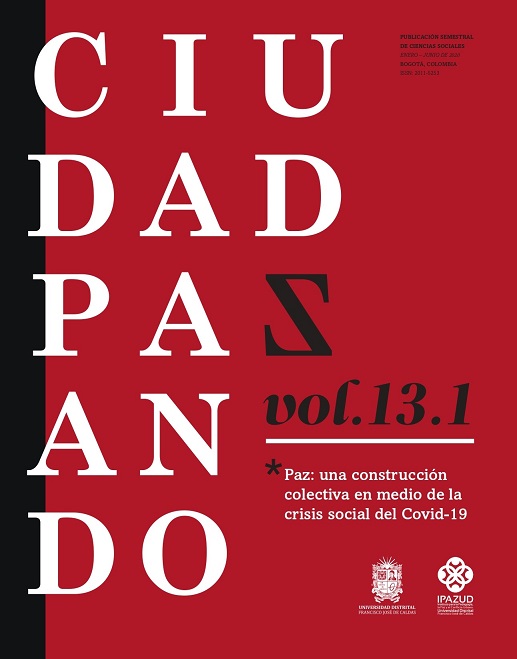DOI:
https://doi.org/10.14483/2422278X.13957Published:
2020-06-30Issue:
Vol. 13 No. 1 (2020): enero-junio. Paz: una construcción colectiva en medio de la crisis social del Covid-19Section:
Dossier centralLos imaginarios de paz: construcción colectiva de estudiantes y maestros
The imaginary of peace: student and teacher collective construction
Keywords:
convivencia, estudiante de secundaria, imaginario, paz (es).Keywords:
coexistence, high school student, imaginary, peace (en).Downloads
Abstract (es)
Partiendo de la pregunta sobre los imaginarios de paz en estudiantes y maestros de educación básica secundaria, se presenta aquí el resultado de entrevistas a grupos focales relacionada con el concepto y el proceso de paz. La unidad de análisis involucra grupos de jóvenes y maestros (dieciocho estudiantes distribuidos en tres grupos de seis y nueve maestros distribuidos en dos grupos). El enfoque cualitativo naturalista e interpretativo y el análisis descriptivo-interpretativo. Se concluyó que existe un vínculo indeleble entre convivencia y paz, los estudiantes se orientan a un concepto de paz como estado anhelado, vivencia en armonía, libertad y justicia, mientras que los maestros lo precisan como un proceso de construcción y responsabilidad social y sitúan el diálogo como dimensión de la misma. Respecto al proceso de paz, los maestros resaltan el esfuerzo loable del Estado colombiano y la reglamentación del Sistema Integral de Verdad, Justicia, Reparación y No Repetición.
Abstract (en)
Starting from the question about peace imaginaries between basic secondary students and teachers , here is presented the result of focus group interviews related to the concept and the peace process. The unit of analysis involves young and teacher groups (eighteen students distributed on three six person groups and nine teachers distributed on two groups). The naturalist and interpretative qualitative focus and descriptive-interpretative analysis. It’s been concluded that there is an invisible link between coexistence and peace, students are oriented to a peace concept as longed-for status, experience in harmony, freedom and justice, meanwhile, teachers precise it as a construction and social responsibility process and they place the dialogue as a dimension of it. On respect to the peace process, teachers highlight the laudable effort of Colombian state and the Integral system of truth, justice, repair and not repeating regulation.
References
Aigneren, M. (2002). La técnica de recolección de información mediante los grupos focales. Revista electrónica: la sociología en sus escenarios, (6).
Ávila, M. (2012). Educación para la paz: un reto educativo. REDHECS: Revista Electrónica de Humanidades, Educación y Comunicación Social, 8(14), 184-195.
Baltork, M., Mansoori, S. y Azad, Y. (2015). Content analysis of peace education as one component of global citizenship education in elementary textbooks. International Journal of Educational and Psychological Researches, 1(1), 28-35.
Cengelci, T. y Gurdogan, O. (2016). Perception of peace in students’ drawings. Eurasian Journal of Educational Research, (65), 181-198.
Chapela, L. (2013). Caja de herramientas en educación para la paz. Organización de las Naciones Unidas para la Educación, la Ciencia y la Cultura
Congreso de Colombia (2017). Acto Legislativo 01 de 2017. http://es.presidencia.gov.co/normativa/normativa/ACTO%20LEGISLATIVO%20N%C2%B0%2001%20DE%204%20DE%20ABRIL%20DE%202017.pdf
Constitución Política de Colombia (1991). Artículo 22.
Erreguerena, M. (2002). Cornelius Castoriadis: sus conceptos. Anuario 2001.
Freeman, M. (2013) Meaning making and understanding in focus groups: Affirming social and hermeneutic dialogue. En B. Dennis, L. Carspecken y P. Carspecken (Eds.). Qualitative Research: A Reader in Philosophy, Core Concepts, and Practice (pp. 131-148). Peter Lang Publishers.
Fuentes, L. (2018). Concepción de paz en estudiante de educación básica [manuscrito no publicado]. Universidad del Magdalena.
Fuentes, L., Pérez, L. y Medrano, Y. (2018). La escuela un espacio de convivencia. en F. Ramos, M., Rodríguez, H., Urzola, y D. Acosta, (Comp.). Formación Educativa en el contexto social y cultural. Volumen III, (pp. 37-52). Fondo Editorial UNERMB.
Palmer, R. (2002). ¿Qué es la hermenéutica? Teoría de la interpretación en Schleiermacher, Dilthey, Heidegger y Gadamer. Arco Libros.
Sagkal, A., Turnuklu, A. y Totan, T. (2012). Empathy for interpersonal peace: Effects of peace education on empathy skills. Kuram ve Uygulamada Egitim Bilimleri, 12(2), 1447-1460.
Organización de las Naciones Unidas para la Educación, la Ciencia y la Cultura [Unesco] (1995). Declaración de principios sobre la tolerancia: aprobada por la Conferencia General de la Unesco. http://unesdoc.unesco.org/images/0015/001518/151830so.pdf
Organización de las Naciones Unidas para la Educación, la Ciencia y la Cultura [Unesco] (2011). Social and Human Sciences.
How to Cite
APA
ACM
ACS
ABNT
Chicago
Harvard
IEEE
MLA
Turabian
Vancouver
Download Citation
License
Copyright (c) 2020 Ciudad Paz-Ando

This work is licensed under a Creative Commons Attribution-NonCommercial-ShareAlike 4.0 International License.
The Ciudad Paz-ando Journal (RCP) is an open access publication, without economic charges for authors or readers, whose biannual publications are made under the terms of the Creative Commons Attribution - Non-commercial - Share the same License (CC-BY-NC -SA 2.5 CO), with which others may distribute, remix, retouch, and create from the work in a non-commercial way, as long as they give credit and license their new creations under the same conditions.
The copyright holder is Ciudad Paz-ando journal, retaining all rights without restrictions, respecting the terms of the license regarding the consultation, download and distribution of the material.
When the work or any of its elements are in the public domain according to the applicable current law, this situation will not be affected by the license.
Likewise, we encourage authors to deposit their contributions in other institutional and thematic repositories, with the certainty that culture and knowledge is a good for all and for all.

